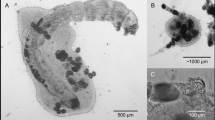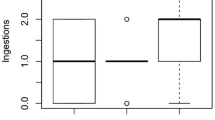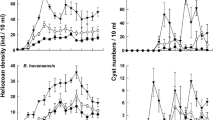Summary
The predatory copepod Mesocyclops edax preys effectively on the rotifers Asplanchna girodi and Polyarthra vulgaris but not on the rotifer Keratella cochlearis. It readily captures individuals of this latter species but usually releases them unharmed, being unable to remove the soft parts within their loricae. The predatory A. girodi regularly eats K. cochlearis but cannot catch P. vulgaris. When P. vulgaris is contacted by the corona of A. girodi, it immediately escapes by elevating its paddles and jumping away a distance up to about ten times its own body length. In experimental communities of these predator and prey species the survival of Polyarthra and Keratella is significantly affected by the species of predator present and by predator-prey interaction between the two predators when both are present.
Similar content being viewed by others
References
Allen, A.A.: Morphology of the planktonic rotifer Polyarthra vulgaris. Trans. Am. Microsc. Soc. 87, 60–69 (1968)
Alimov, F., Boullion, V.V., Finogenova, N.P., Ivanova, M.B., Kuzmitskaya N.K., Nikulina, V.N., Ozeretskovskaya, N.G., Zharova, T.V.: Biological productivity of Lakes Krivoe and Krugloe. In: Productivity problems of freshwaters (Z. Kajak, A. Hillbricht-Ilkowska, eds.), pp. 39–56. Warsaw-Cracow: Polish Scientific Publishers 1972
Anderson, R.S.: Zooplankton composition and change in an alpine lake. Verh. Int. Verein. Limnol. 18, 264–268 (1973)
Brandl, Z., Fernando, C.H.: Prey selection by the cyclopoid copepods Mesocyclops edax and Cyclops vicinus. Verh. Int. Verein. Limnol. 20 (in press)
Burckhardt, G.: Verarmung des Planktons in Kleinen Seen durch Heterocope. Schweiz. Z. Hydrol. 10, 121–124 (1944)
Edmondson, W.T.: Reproductive rates of rotifers in natural populations. Mem. Inst. Ital. Idrobiol. 12, 21–77 (1960)
Ejsmont-Karabin, J.: Studies on the feeding of planktonic polyphage Asplanchna priodonta Gosse (Rotatoria). Ekol. Pol. 22, 311–317 (1974)
Erman, L.A.: On the utilization of the reservoirs trophic resources by plankton rotifers [in Russian]. Byull. Mosk. Obshch. Ispyt. Prir. 67, 32–47 (1962)
Gilbert, J.J.: Rotifer ecology and embryological induction. Science 151, 1234–1237 (1966)
Gilbert, J.J.: Asplanchna and posterolateral spine production in Brachionus calyciflorus Arch. Hydrobiol. 64, 1–62 (1967)
Gilbert, J.J.: Polymorphism and sexuality in the rotifer Asplanchna, with special reference to the effects of prey-type and clonal variation. Arch. Hydrobiol. 75, 442–483 (1975)
Gilbert, J.J.: Selective cannibalism in the rotifer Asplanchna sieboldi: contact recognition of morphotype and clone. Proc. Natl. Acad. Sci. USA 73, 3233–3237 (1976)
Gilbert, J.J.: Control of feeding behaviour and selective cannibalism in the rotifer Asplanchna. Freshwat. Biol. 7, 337–341 (1977)
Gilbert, J.J., Litton, J.R., Jr.: Sexual reproduction in the rotifer Asplanchna girodi: effects of tocopherol and population density. J. Exptl Zool. 204, 113–122 (1978)
Gliwicz, Z.M.: Studies on the feeding of pelagic zooplankton in lakes with varying trophy. Ekol. Pol. 17, 663–708 (1969)
Green, J., Lan, O.B.: Asplanchna and the spines of Brachionus calyciflorus in two Javanese sewage ponds. Freshwat. Biol. 4, 223–226 (1974)
Guiset, A.: Stomach contents in Asplanchna and Ploesoma. Arch. Hydrobiol. Beih. 8, 126–129 (1977)
Hall, D.J., Threlkeld, S.T., Burns, C.W., Crowley, P.H.: The size-efficiency hypothesis and the size structure of zooplankton communities. Ann. Rev. Ecol. Syst. 7, 177–208 (1976)
Hillbricht-Ilkowska, A., Kajak, Z., Ejsmont-Karabin, J., Karabin, A., Rybak, J.: Ecosystem of the Mikolajskie Lake. The utilization of the consumers production by invertebrate predators in pelagic and profundal zones. Pol. Arch. Hydrobiol. 22, 53–64 (1975)
Kerfoot, W.C.: Implications of copepod predation. Limnol. Oceanogr. 22, 316–325 (1977a)
Kerfoot, W.C.: Competition in cladoceran communities: the cost of evolving defenses against copepod predation. Ecology 58, 303–313 (1977b)
Kosova, A.A.: Seasonal changes in plankton and benthos in the poloys of the lower zone of the Volga delta [in Russian]. Tr. Vsesojuzn. Gidrobiol. Obshch. 10, 102–134 (1960)
Lynch, M.: Fitness and optimal body size in zooplankton populations. Ecology 58, 763–774 (1977)
Makarewicz, J.C.: The community of zooplankton and its production in Mirror Lake. Doctoral Dissertation, Cornell University, Ithaca, New York, 206 pp. (1974)
McQueen, D.J.: Reduction of zooplankton standing stocks by predacious Cyclops bicuspidatus thomasi in Marion Lake, British Columbia. J. Fish. Res. Bd. Canada 26, 1605–1618 (1969)
Nauwerck, A.: Die Beziehungen zwischen Zooplankton und Phytoplankton im See Erken. Symb. Bot. Upsal. 17, 1–163 (1963)
Pejler, B.: Taxonomical and ecological studies on planktonic Rotatoria from central Sweden. K. Svenska Vetensk Akad. Handl., ser. 4, 6, (7), 1–52 (1957)
Pejler, B.: The zooplankton of Ösbysjön, Djursholm. I. Seasonal and vertical distribution of the species. Oikos 12, 225–248 (1961)
Pejler, B.: Regional-ecological studies of Swedish freshwater zooplankton. Zool. Bidrag. Uppsala 36, 407–515 (1965)
Sokal, R.R., Rohlf, F.J.: Biometry, pp. 1–776. San Francisco: Freeman 1969
Winberg, G.G., Babitsky, V.A., Gavrilov, S.I., Zakhagenkov, I.S., Kovalevskaya, R.Z., Mikheeva, T.M., Nevyadomskaya, P.S., Ostapenya, A.P., Petrovich P.G., Potaenko, J.S., Yakushko, O.F.: Biological productivity of different types of lakes. In: Productivity problems of freshwaters (Z. Kajak, A. Hillbricht-Ilkowska, eds.), pp. 383–404. Warsaw-Cracow: Polish Scientific Publishers 1972
Zimmerman, C.: Die pelagischen Rotatorien des Sempachersees mit spezieller Berücksichtigung der Brachioniden und der Ernährungsfrage. Schweiz. Z. Hydrol. 36, 205–300 (1974)
Author information
Authors and Affiliations
Additional information
Supported by National Science Foundation research grant DEB 76-09768 and Public Health Service career development award KO4-GM 70557 to J.J.G.
Rights and permissions
About this article
Cite this article
Gilbert, J.J., Williamson, C.E. Predator-prey behavior and its effect on rotifer survival in associations of Mesocyclops edax, Asplanchna girodi, Polyarthra vulgaris, and Keratella cochlearis . Oecologia 37, 13–22 (1978). https://doi.org/10.1007/BF00349987
Received:
Issue Date:
DOI: https://doi.org/10.1007/BF00349987




